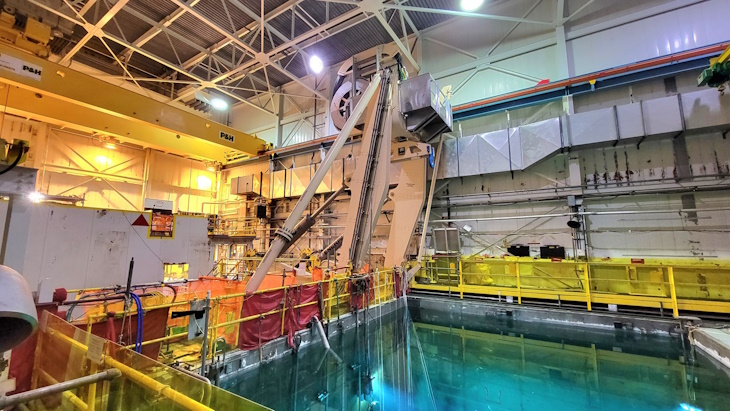The heavy load handling technology allows modern casks and canisters to be safely loaded, even when they are beyond the limits of the plant's installed cranes, saving time and money over conventional methods, the company said.

HI-LIFT in action at Indian Point 3 (Image: Holtec International)
Nuclear power plants typically incorporate a permanently installed overhead crane which is used to lift heavy components into place during the plant's construction. The crane is also used during the plant's operational life, for example to remove the reactor vessel head during refuelling and maintenance outages. At the end of a plant's life, the crane can also be used during the decommissioning process.
However, the heavy casks that are in use today for dry storage of used nuclear fuel are beyond the civil/structural load bearing capacity of plants build in the 1960s and 1970s. HI-LIFT overcomes this by using a "structurally competent" portion of the building to support the system's pivoting arms, bypassing weak regions. The system was initially designed and used for the removal of used fuel during the decommissioning of Pacific Gas & Electric's Humboldt Bay Power Plant in 2007-2008. That plant operated from 1963 to 1976, but according to Holtec the plant's own crane dated back to 1947 and the wall structure supporting it was qualified for only 40 tonnes.
Using HI-LIFT to handle Holtec's HI-STAR HB dual purpose casks without stressing Humboldt Bay's existing crane or supporting walls resulted in "substantial" savings both in time and money: strengthening the load bearing walls and installing a new high-capacity bridge crane would have added on at least three years to the project, the company said.
The US Nuclear Regulatory Commission approved the use of the same system at Indian Point 3, which shut down in April 2021 after 45 years in operation. Engineering and installing an 100-tonne HI-LIFT crane at unit 3 has cost less than USD10 million, Holtec said. This is substantially less than the reported USD60 million spent by the plant's previous owner to upgrade the crane and strengthen supporting walls at Indian Point 2, which shut down in April 2020.
Using the HI-LIFT system will also streamline and reduce the number of used fuel movements needed to defuel Indian Point 3: the defuelling campaign is expected to take about six months.
Holtec purchased the Indian Point Energy Center in New York State from Entergy in June 2021 following the closure of unit 3 in April of that year. The site also includes the shut-down Indian Point 1, a 257 MWe (net) pressurised water reactor which operated between 1962 and 1974.
Researched and written by World Nuclear News